A not so shy roe deer showed up on our doorstep. Next thing we know, it’ll be letting us stroke it!
Here is one of our regular visitors, the roe deer. This one is looking very intently at his two companions in the trees. We have had a stable population of three or four roe deer who include our land in their territory for over a decade. I decided to do a bit of nature study on my own and find out more about them. Until this morning I didn’t know their name in English.
The things that interested me most are the interactions between humans and the roe deer. Like many ubiquitous animals in populated areas, it has proved good at adapting to a humanised environment. Although it prefers to eat leaves, it will graze on young crops for example. In the absence of predators other than humans, its population is rather dense. The worst thing about this is that it encourages the spread of lyme disease, and other parasites and diseases that may affect the deer primarily. It seems that the deer can also limit the rejuvenation of forests. I must say that they don’t seem to be doing such a good job of that on our land. It’s also shocking to learn that in the absence of predators, roadkill is one of the most common causes of death. Striking an animal of this size is obviously also dangerous to the humans in the car.
Nature study has many facets, and this morning made me remember the social and political aspects as well. As societies and individuals, we all have to make decisions related to nature. In France, the possible reintroduction or natural return of large predators is one vector of social debate. In practical terms, right now, the main predators are human hunters, and the roe deer is one of the more common prey.
I knew very little about hunting around here, and decided it was time to find out more. It turns out the situation is rather complicated. Hunting varies a lot legally and culturally within Europe, and presumably even more elsewhere. Before the French revolution, hunting was largely a privilege of the aristocracy. At the revolution, the right to hunt was granted to everybody. It became one of those liberties that many people are emotionally attached to, rather like the right to carry guns in the US. Of course, there is no such thing as unattributed land in France, and the universal right to hunt essentially meant that anyone could hunt on anyone else’s property at any time.
In modern times there have been some changes. As a society ‘we’ use hunting to regulate the numbers of some species, and ban or severely limit hunting of other species. Quotas apply to most species, and there may be selection procedures in place. Although anyone can hunt, in most places it’s obligatory to join a local association. And, after several massive fights in the European courts, French landowners can now declare their own property as a no-hunt zone. Information like the opening and closing of the hunting season, and the various quotas should be easily accessible to the public, and actually, I found it on the internet without too much trouble – not so common in France!
In practical reality, this is the face of hunting we see as spectators: autumn around here sees the country roads lined with men hanging around on their 4-wheel drive jeeps and toting rifles, clearly enjoying the macho, male-bonding experience. Meanwhile, their dogs are busy getting lost all over the mountains, sometimes showing up on people’s doorsteps weeks later. And a few of the more timorous residents complain that they hardly dare take a walk during the season. I must admit I’ve never heard of a real accident. But it’s hard to believe, looking at this lot, that they actually have a clue what they’re doing. And some part of me would really, really like to see a few women try to join their little hunting club. It’s just so darned obvious that that would spoil their fun.
For me and for my daughter in the future, there are lots of decisions to make, choices that are emerging in our society from a combination of individual and group action. Other societies are dealing with different situations and consequences even around a similar topic like hunting. Nature study is also valuable for hopefully allowing our decisions to be made based on real knowledge, rather than on knee-jerk reactions.
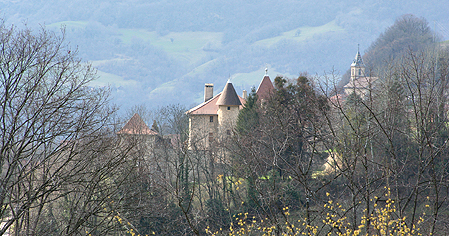
We’re busy exploring new paths in our area. Here is our village from perhaps its most traditional perspective: the church, the chateau and an old farm building. I had never seen this view before. Ours is a very spread out community which is traditional for this area, with many outlying hamlets and isolated farms several miles away from these focal points. The latest mayor seems to be into development at all costs, and has allowed an ugly smear of new sun-catching dormitory houses to spring up in the prairie between the chateau and the church. I haven’t really figured out why. Fortunately, a lot of the terrain around here is just too steep to build on.
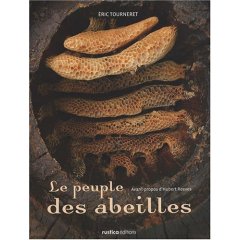
I bought this book just as a treat, because the pictures in it are too beautiful. Now the passion for honeybees is growing on me and Antonia. In another life, a life in which my husband was not allergic to honey and I traveled less, I think I would be a beekeeper. I’m fascinated by their senses, their communication, their life cycles and their castes. I’m blown away that they have five eyes of two different types, and two kinds of ‘ears’. And that the workers cycle through a series of tasks during their life, from comb maintenance to brood nursing, guarding to gathering, and that they develop the appropriate organs accordingly. And the stuff that they collect and produce is so attractive to the senses: pollen, nectar, honey, wax, propolis. They’re so furry, I could cuddle them if they didn’t sting, and they have such a hypnotic hum.
In my dreams, I would have a natural observation hive, in which I could just watch the bees do their own thing, and maybe pinch one of their smaller combs from time to time. In fact, the hive I want is this one, below. Maybe I could get those people to swap houses with me! The wild combs are so beautiful, I just can’t help wanting to reach up and steal one, and munch straight into it. They look like galettes, and they must be appealing to some very primitive instinct in me. I don’t think the manmade combs are pretty at all.
Taken by Max xx, a fellow Brit in France, apparently, from Flickr with a CC licence.
Poor bees. They have been having such a hard time lately. It would practically be a civic duty to let some live behind my shutters. Can you just hear me talking myself into something here? In my obsession, I’ve been reading everything I can find about bees. Some proponents of natural bee-keeping like this one, think the bees will do better in more natural conditions. Standard bee-keeping encourages them to build bigger cells and bigger bodies, produce more honey and less wax than they might choose, get moved around so that they produce honey from single plants, refrain from their usual reproductive activities if possible, and live off sugar syrup once the results of their labour has been harvested. When you look at it like that, it’s no wonder they’re struggling. And those nasty artificial combs don’t look nearly so hygienic, safe or well-ventilated as the natural ones, to me.
I was musing on this today, and it suddenly struck me as a pretty good metaphor of homeschooling versus schooling. Like the standard hives, schools provide a ‘safe’, prepared environment that’s designed to draw out some human characteristics further than they might otherwise go while repressing others, and train kids in the habit of over-productivity. Turns out the environment isn’t as safe as all that, and the kids end up weakened in various ways. Then lots of us go on to live adult lives that are much the same. Too much working to produce honey/knowledge/money and the honey ends up too thin, too purified and easily diverted to other people’s ends. Not enough wax, the relationships and life skills that hold people’s lives together in the first place. Bzzzzzz…. I imagine this metaphor will only make sense to me.
It’s one of those Charlotte Mason things: get outdoors every day, even if it’s raining. The rain won’t actually hurt you! So I thought we’d try it and see what it’s like (well OK, I used to do a paper round and walk a dog, come hell or high water). So – here we are at the freezing point, in sleet actually. Antonia has been dancing around trying to see how much water she can catch in a plastic cup and refusing to use an umbrella. For some reason she then decided to tip freezing water all over her jeans. She wasn’t soooo happy, until she got distracted by muddy puddles, mud, shiny pebbles with mud on and footprints in the mud. I was the only one who seemed to notice or care that all the mosses and lichens were twice as big and green as usual. Mike crouched under his umbrella, shivering. It was all pretty good fun, though three-quarters of an hour is probably enough.
I’m sure the other two will agree that it made it extra nice to come home, stoke up the fire, make hot chocolates, and snuggle up under the covers with Swan Lake on dvd for Antonia and a book for me.
I usually only post highlights of our nature walks. Here is a typical example of the whole thing.
The orientation of the slope and the seasons
On a warm, sunny afternoon, there is still hail from last night on the ground near our house.
Not much further on, we turn to a south-facing slope, where we find very early signs of spring. The difference between winter and spring is 100 metres – the length of our driveway as we measured it !
Last year’s dead flower heads still dominate the landscape.
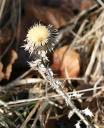
Our neighbour is away today. Her son has been to prune the trees, another sign of spring.
Some history and social studies

It isn’t so easy to recognise this as a rotting cart wheel, but elsewhere in the village they are used as decorations. We pass the boys’ den in a ruined barn.
Further on, we clamber down a slope to collect some litter that will return home with us to be recycled. Futher on, we decipher the signs at the entrance to the farmer’s field. We talk about why he wants us to stay near the edge, and what the electric fence is for. But is it on right now?
We pick out the trail signs for the village footrace at all the intersections. The number of kilometres left to go is also marked out, so we know it is one kilometre to favourite stream.
but our own ruin is right down by the stream where we clamber about the walls of an old mill and over the millstone.
The hazlenut tree
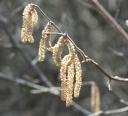
The male flowers are very obvious right now, and if you shake them, their pollen flies off in great drifts. Usually, this is the wind’s job.
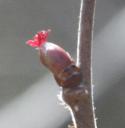
The female flowers are much harder to see.
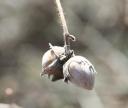
And it’s rather unusual to find a ‘baby’ left over from last year.
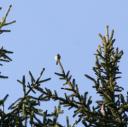
Hard to spot, but at least we recognise the alarm call of the great tit tribes who have spotted us.
Time for an experiment
There’s usually something going on during a walk: a game, a measurement, a drawing or sculpture, a construction or a sport. Today, it’s an experiment.
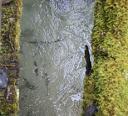
Sticks float, don’t they? Except that we were surprised to discover that about half of them didn’t. You can see them lying there on the bottom of the stream.
Mosses and lichens
This is a great time of year for observing mosses and lichens.

They lay siege to thin stalks and whole tree trunks in the same way, rising like green pyramids.
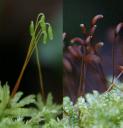
We can tell there are many different kinds, but moss identification is tough. It may start here, with the different spore capsules.
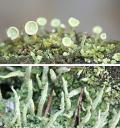
The lichens are also in full reproductive glory.
An exploration and mystery or two
It’s easy to move into new areas with the undergrowth gone.
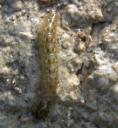
In a quiet, sunny part of the stream under a fossil-filled rock, we discovered a creature.
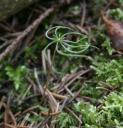
And this tiny windmill? Maybe it’s a baby conifer?
The sunset
It’s a long way home, but a sunset over the whole valley is waiting for us at the end.

A new look at Favourite Stream. About a mile further up than usual, and already much narrower.
Here’s our latest exploration of a new part of Favourite Stream, led by Antonia. Fortunately, February is one of the best times for exploring the wilderness, with hardly any prickly undergrowth under the trees.
Antonia clambering up a small tributary stream.
The improvised crossing
Last year, observation was the main theme of our nature study. Antonia learned to really, really notice all kinds of things around her, especially very small things. I didn’t really plan it like that, and it was really exciting for both of us to see her skill and curiosity growing. At the same time, she got comfortable being out of doors, which was certainly not the case when we began homeschooling.
Now, a change is taking place. For one thing, she has really come into her own, physically. Even other adults who know her have noticed it. She runs like the wind, climbs as if it was nothing, outgrew her beginner’s skipass in one day… And she’s become very exploration orientated on our nature walks. She wants to know what’s down all the other paths, or where you get to if you follow the stream. I think it’s partly because physically she can, and partly a change in the way she perceives the world. In fact, although we obviously have more than enough developmental stages to measure kids against, I think if we’re to have them at all, the desire to follow streams and rivers really should be one of them. Until recently, the idea simply didn’t occur to her. Along with this change, she’s started making her own maps and has become fascinated by compass directions. She’s been able to do the grade-level appropriate map-reading exercises for some time, but I think it was more a game to her, not a tool for understanding or communicating the world.
 I suppose this counts as socialisation. At any rate it’s a situation Little Miss wouldn’t have been too happy in a year ago. Fast, noisy, crowded, fairly rough and nobody she knows. But there she goes… It’s the winter holidays over here, and the playgrounds are busy.
I suppose this counts as socialisation. At any rate it’s a situation Little Miss wouldn’t have been too happy in a year ago. Fast, noisy, crowded, fairly rough and nobody she knows. But there she goes… It’s the winter holidays over here, and the playgrounds are busy.

Meanwhile, I was busy watching the local crows fishing bread out of the pond. Bread intended for the ducks of course. I knew crows were clever, but I didn’t know they did this!
We don’t usually do Valentine’s Day around here. How come I suspect someone who spent two weeks away from his daughter could refuse her nothing? I’m very happy to see some spring flowers anyway. We had fun examining the new buds in detail.
 The primroses hide down under the older leaves and flowers. Their sepals gradually get pushed back to reveal the colour.
The primroses hide down under the older leaves and flowers. Their sepals gradually get pushed back to reveal the colour.
 This (is it a Begonia? – no, it’s a Cyclamen, thanks, Marie) keeps its petals furled up. It was only on closer inspection that we noticed that the stem doesn’t unbend. The petals just open till they point straight upwards, and the flower stays upside down.
This (is it a Begonia? – no, it’s a Cyclamen, thanks, Marie) keeps its petals furled up. It was only on closer inspection that we noticed that the stem doesn’t unbend. The petals just open till they point straight upwards, and the flower stays upside down.
 The daffodil pushes up from the sheath at the top of the bulb. It grows from the outside of the plant, not the centre, as the primroses do.
The daffodil pushes up from the sheath at the top of the bulb. It grows from the outside of the plant, not the centre, as the primroses do.
 The Hyacinth doesn’t seem to make new buds. But the flowers at the tip of the stem are still tinged with green.
The Hyacinth doesn’t seem to make new buds. But the flowers at the tip of the stem are still tinged with green.